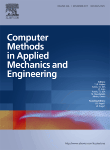Franke, M.; Ortigosa, Rogelio; Martínez-Frutos, Jesús; Gil, Antonio J.; Betsch, P. A thermodynamically consistent time integration scheme for non-linear thermo-electro-mechanics Journal Article In: Computer Methods in Applied Mechanics and Engineering, vol. 389, pp. 114298, 2022, ISSN: 0045-7825. Abstract | BibTeX | Tags: DICOPMA, Dielectric elastomers, Electro active polymers, Energy–momentum scheme, Finite element method, Nonlinear thermo-electro-elastodynamics, Polyconvexity, Tensor cross product | Links: Ortigosa, Rogelio; Gil, Antonio J.; Martínez-Frutos, Jesus; Franke, M.; Bonet, Javier A new energy–momentum time integration scheme for non-linear thermo-mechanics Journal Article In: Computer Methods in Applied Mechanics and Engineering, vol. 372, pp. 113395, 2020, ISSN: 0045-7825. Abstract | BibTeX | Tags: DICOPMA, Energy–momentum scheme, Finite element method, Nonlinear thermo-elastodynamics, Structure-preserving discretisation | Links: 2022

@article{FRANKE2022114298,
title = {A thermodynamically consistent time integration scheme for non-linear thermo-electro-mechanics},
author = {M. Franke and Rogelio Ortigosa and Jesús Martínez-Frutos and Antonio J. Gil and P. Betsch},
url = {https://www.sciencedirect.com/science/article/pii/S0045782521005922},
doi = {https://doi.org/10.1016/j.cma.2021.114298},
issn = {0045-7825},
year = {2022},
date = {2022-01-01},
urldate = {2022-01-01},
journal = {Computer Methods in Applied Mechanics and Engineering},
volume = {389},
pages = {114298},
abstract = {The aim of this paper is the design of a new one-step implicit and thermodynamically consistent Energy–Momentum (EM) preserving time integration scheme for the simulation of thermo-electro-elastic processes undergoing large deformations. The time integration scheme takes advantage of the notion of polyconvexity and of a new tensor cross product algebra. These two ingredients are shown to be crucial for the design of so-called discrete derivatives fundamental for the calculation of the second Piola–Kirchhoff stress tensor, the entropy and the electric field. In particular, the exploitation of polyconvexity and the tensor cross product, enable the derivation of comparatively simple formulas for the discrete derivatives. This is in sharp contrast to much more elaborate discrete derivatives which are one of the main downsides of classical EM time integration schemes. The newly proposed scheme inherits the advantages of EM schemes recently published in the context of thermo-elasticity and electro-mechanics, whilst extending to the more generic case of nonlinear thermo-electro-mechanics. Furthermore, the manuscript delves into suitable convexity/concavity restrictions that thermo-electro-mechanical strain energy functions must comply with in order to yield physically and mathematically admissible solutions. Finally, a series of numerical examples will be presented in order to demonstrate robustness and numerical stability properties of the new EM scheme.},
keywords = {DICOPMA, Dielectric elastomers, Electro active polymers, Energy–momentum scheme, Finite element method, Nonlinear thermo-electro-elastodynamics, Polyconvexity, Tensor cross product},
pubstate = {published},
tppubtype = {article}
}
2020

@article{ORTIGOSA2020113395,
title = {A new energy–momentum time integration scheme for non-linear thermo-mechanics},
author = {Rogelio Ortigosa and Antonio J. Gil and Jesus Martínez-Frutos and M. Franke and Javier Bonet},
url = {https://www.sciencedirect.com/science/article/pii/S0045782520305806},
doi = {https://doi.org/10.1016/j.cma.2020.113395},
issn = {0045-7825},
year = {2020},
date = {2020-01-01},
urldate = {2020-01-01},
journal = {Computer Methods in Applied Mechanics and Engineering},
volume = {372},
pages = {113395},
abstract = {The aim of this paper is the design a new one-step implicit and thermodynamically consistent Energy–Momentum (EM) preserving time integration scheme for the simulation of thermo-elastic processes undergoing large deformations and temperature fields. Following Bonet et al. (2020), we consider well-posed constitutive models for the entire range of deformations and temperature. In that regard, the consideration of polyconvexity inspired constitutive models and a new tensor cross product algebra are shown to be crucial in order to derive the so-called discrete derivatives, fundamental for the construction of the algorithmic derived variables, namely the second Piola–Kirchoff stress tensor and the entropy (or the absolute temperature). The proposed scheme inherits the advantages of the EM scheme recently published by Franke et al. (2018), whilst resulting in a simpler scheme from the implementation standpoint. A series of numerical examples will be presented in order to demonstrate the robustness and applicability of the new EM scheme. Although the examples presented will make use of a temperature-based version of the EM scheme (using the Helmholtz free energy as the thermodynamical potential and the temperature as the thermodynamical state variable), we also include in an Appendix an entropy-based analogue EM scheme (using the internal energy as the thermodynamical potential and the entropy as the thermodynamical state variable).},
keywords = {DICOPMA, Energy–momentum scheme, Finite element method, Nonlinear thermo-elastodynamics, Structure-preserving discretisation},
pubstate = {published},
tppubtype = {article}
}









